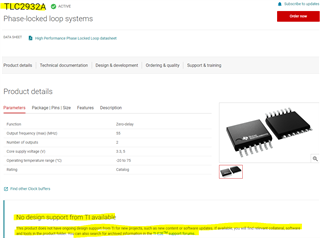Other Parts Discussed in Thread: TLC2932A,
Hello,
I am currently using only the Phase Detector (PFD) part of the TLC2933A High-Performance Phase-Locked Loop chip with a supply voltage of 5.0V. I am not using the VCO part of chip at all. The datasheet indicates that PFDs in the chip can be operated up to at least 65MHz (or 38MHz for the TLC2932A) at 5.0V; however, the frequency of the signals I am applying to the FIN-A and FIN-B inputs is only about 3 MHz.
My connections to the chip are as follows:
Pin 1: 5.0V
Pin 2: Ground
Pin 3: No connection
Pin 4: 3 MHz square wave, 5.0V amplitude
Pin 5: 3 MHz square wave, 5.0V amplitude
Pin 6: To loop filter in my design
Pin 7: Ground
Pin 8: Ground
Pin 9: Ground
Pin 10: 5.0V
Pin 11: Ground
Pin 12: 5.0V
Pin 13: 5.0V via 3k3 resistor.
Pin 14: 5.0V
My questions:
1. Is it OK to operate the PFD in the TLC2933A (or the TLC2932A) with such low input frequencies?
2. Will the performance of the PFD be affected by such a low operating frequency?
3. Would there be any advantage in me using the '2932A instead of the '2933A?
4. Do you have any application information for the chips other than what is in the datasheet?
5. One unfortunate problem with the type PFD used in the chips (which is also the case for other PLL chips) is that it suffers from a "dead-zone" - i.e. it produces no output pulses on Pin 6 when the input signals are in-lock (which gives rise to ripple in Phase-Locked Loop circuits). Do TI have under development any other PLL chips that can cure this problem? (The Type-II Phase Detector in Nexperia's 74HCT9046A does not suffer from this problem but that chip is unfortunately becoming obsolete.).
Regards,
Ali


